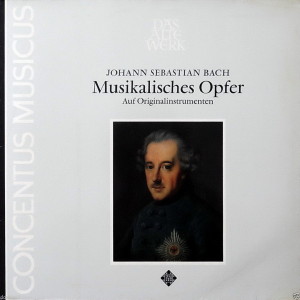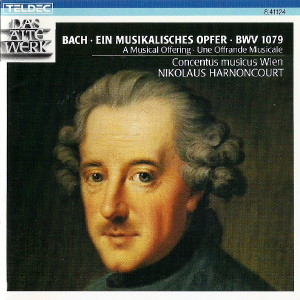 |
1 LP -
SAWT 9565-B - (p) 1970
|
 |
| 1 CD -
8.41124 ZK - (c) 1986 |
|
| Johann
Sebastian Bach (1685-1750) |
|
|
|
|
|
|
|
Ein
Musicalisches Opfer, BWV 1079
|
|
|
|
| (Titel nach
dem Autograph der Widmungsvorrede für
König Friedrich II, von Preußen) |
|
|
|
|
|
|
|
Ricercare
a 3 (Cembalo)
|
|
6' 05" |
A1 |
Canon
perpetuus super thema regium (Flauto
traverso, Violine, Tenorviola)
|
|
0' 58" |
A2 |
5
Canones diversi super thema regium:
|
|
6' 48" |
|
- Canon
a 2 (Cembalo)
|
0' 57" |
|
A3 |
| - Canon
a 2 Violini in unisono (2 Violinen,
Cembalo, Violoncello) |
0' 56" |
|
A4 |
- Canon
a 2 Per motum contrarium (Flauto
traverso, Violine, Viola)
|
0' 39" |
|
A5 |
- Canon
a 2 Per augmentationem, contrario motu
(2 Violinen, Tenorviola)
|
1' 52" |
|
A6 |
- Canon
a 2 Per tonos (Violine, Viola,
Tenorviola)
|
2' 24" |
|
A7
|
Fuga
canonica in Epidiapente (Flauto
traverso, Violine, Cembalo, Violoncello)
|
|
1' 52" |
A8 |
Ricercare
a 6 (Cembalo)
|
|
7' 02" |
A9 |
| Canon a
2 (Cembalo) |
|
1' 17" |
B1 |
| Canon a
4 (Flauto traverso, 2 Violinen,
Cembalo, Violoncello) |
|
2' 03" |
B2 |
Trio
(Flauto traverso, Violine, Cembalo,
Violoncello):
|
|
18' 09" |
B3 |
- Largo
|
5' 52" |
|
|
| - Allegro |
6' 24" |
|
|
| - Andante |
2' 47" |
|
|
- Allegro
|
3' 06" |
|
|
Canon
perpetuus (Flauto traverso, Violine,
Cembalo, Violoncello)
|
|
1' 40" |
B4 |
|
|
|
|
Concentus Musicus
Wien (mit Originalinstrumenten)
|
|
-
Herbert Tachezi, Cembalo
(Niederländischer Bauwiese von R.
Schütze, Heidelberg)
|
|
| -
Leopold Stastny, Flauto traverso
(A. Grenser, Dresden, Mitte 18
Jh.) |
|
| -
Alice Harnoncourt, Violine
(Jacobus Stainer, Absam 1665) |
|
| -
Walter Pfeiffer, Violine
(Mattias Albanus, Bozen 1712) |
|
| -
Kurt Theiner, Viola (Marcellus
Hollmayr, Wien um 1650) |
|
| -
Nikolaus Harnoncourt, Tevorviola
(Tirol um 1650) und Violoncello
(Andrea Castagneri, Paris 1744) |
|
|
|
| Nikolaus
Harnoncourt, Leitung |
|
|
Luogo
e data di registrazione
|
| Casino Zögernitz, Vienna
(Austria) - febbraio / marzo 1970 |
|
Registrazione
live / studio
|
| studio |
Producer
/ Engineer
|
Wolf
Erichson
|
Prima Edizione CD
|
| Teldec
"Das Alte Werk" - 8.41124 ZK - (1 cd) -
46' 40" - (c) 1986 - ADD |
Prima
Edizione LP
|
Telefunken "Das
Alte Werk" - SAWT 9565-B - (1 lp) - 46'
40"
- (p) 1970
|
|
|
Notes
|
In
the Spring of 1747, Bach
traveled to Berlin with his
son Friedemann to visit
Philipp Emanuel who was
engaged as chamber
harpsichordist at the court
of Frederick ll. The
“Berlinische Nachrichten“ of
May 11,1747 carried a report
of his visit. “From Potsdam
we learn that on the Sunday
just past (May 7) the famous
Capellmeister from Leipzig.
Mr. Bach, arrived in the
city for the purpose of
enjoying the pleasure of
hearing the excellent Royal
Music here. ln the evening,
shortly before the time that
the chamber music
customarily commences in the
King's apartements, it was
reported to His Majesty that
Capellmeister Bach had
arrived in Potsdam and that
he has waiting in the
ante-chamber in the hope of
receiving His Majesty’s
permission to attend the
performance of the music.
His Majesty immediately
ordered his admission and,
upon his entry,went to the
so-called "Forte and Piano"
(the newly invented
Hammerklavier) and without
any preparation personally
condescended to play
Capellmeister Bach a theme
that the latter should
improvise into a fugue. This
was accomplished by the
aforesaid Capellmeister Bach
so successfully that not
only was His Majesty
inclined to indicate his
pleasure, but all other
persons present were given
to great astonishment. Mr.
Bach found the theme so
exceedingly lovely that he
wanted to write it down on
paper as a properfugue and
have it engraved on copper.
There is also another
account of this memorable
visit, namely, the
dedication with which Bach
prefaced the "Musical
Offering": "Most
respectfully I do hereby
dedicate a ’Musical
Offering’ to Your Majesty,
from whose hand the noblest
part personally stems. lt is
with reverential pleasure
that l still recall the very
exceptional Royal kindness
when, upon my presence in
Potsdam some time ago, Your
Majesty personally
condescended to play me a
theme for a fugue on the
piano and at the same time
most graciously enjoined
upon me that it be
improvised immediately in
the presence of Your High
Person. To obey Your
Majesty's command was my
most respectful duty. I soon
noticed, however, that due
to the lack of the necessary
preparation the
improvisation did not want
to succeed as befitted such
an excellent theme.
Thereupon I resolved, and
undertook forthwith to work
out this very Royal theme
more perfectly and then to
make it known to the world.
Within my powers, this
resolution has now been
realized..."
Completely sold to the
modern musical style of
Graun and Hasse, the young
king of Prussia wanted to
hear the legendary
grandmaster of improvisation
and counterpoint. At the
same time he wanted to lake
a look into the musical past
by having the most famous
master of the old - by that
time already 'antiquated' -
style display his prowesses.
It was totally clear to Bach
that he was hardly any
longer respected there as a
fully valid musician since
even his sons also composed
exclusively in the modern
style.
Bach politely praised the
theme altough it was
entirely unsuited for use as
a fugue theme. lt is
probable that the musically
versed king deliberately
posed such a difficult theme
to see how Bach would get
around it.
The composer’s answer was
indeed just as ingenious and
clever: He had received an
almost unsolvable task and
responded with an almost
insurmountable task for the
flute-playing king. The Trio
Sonata for Flute, Violin and
Continuo was almost
impossible to play on the
flute of that time.
Frederick cannot possibly
have played the sonata, but
perhaps his flute-teacher
Quantz did. On July 7, 1747,
in the name of his father,
Bach’s son Carl Philipp
Emanuel (then court
harpsichordist of Frederick
the Great) presented the
king an engraved copy of the
"Musical Offering." Bach had
dedicated the work to His
Royal Majesty "most
respectfully" after his
visit at Potsdam had
inspired him to Write it .
The thema regium, the
improvisation of which had
at the time not wanted to
“succeed”, he had "worked
out more perfectly" and
wanted then to "make it
known to the world" by
having it printed.
Although to a great extent
Bach's scoring can be
determined from his markings
and musical demands,
distorting revisions and
attempts at instrumentation
especially of the two
ricercare, have often been
made.
The work is opened by a
three-part ricereare (an old
term designating a movement
in fugue style) for
harpsichord. This fugue of
great dimensions is followed
by a series of canons that
are miniature gems of
counterpoint. There are very
few indications of the
scoring for this part,
Still, since some
instruments are definite the
transverse flute in the Trio
in the Canon perpetuus, the
two violins in Canon a 2,
and the Cello as bass
instrument in the Trio and
the Canon perpetuus, the
division of parts becomes
almost self-evident. A viola
and a tenor viola need to be
added to but a few of the
canons. Some of the voices,
by way of their range, show
that they are flute parts.
Flute and bass play the
first canon in double
octaves while the violin
plays the thema regium as
cantus firmus. - The next
five canons are as different
in construction and tonal
structure as can be
imagined: In the first canon
(for two voices) the same
part is simultaneously
played in its normal forward
movement and cancrizans, in
crab fashion. The second
canon is for two violins
playing at the unison - the
answering voice enters one
measure after the first -
above a harpsichord
accompaniment of the theme.
In the third canon the top
voice plays the subject
while the second and third
play per motum contrarium,
hence in contrary motion,
answering a half-measure
later. Above the fourth
canon per augmentationem,
contrario motu (by
augmentation and contrary
movement) Bach wrote in
Latin “Like the note values,
may the king’s happiness
also increase.” This
complicated canon is
executed by the first and
third voices; the lower
voice part must be repeated
so that the inversion in the
upper voice can answer by
playing the entire piece in
notes of doubled length. The
last canon of this group is
taken per tonos (through
various keys); it, too, has
a symbolical meaning: “Like
the ascending modulation,
may the king's glory also
rise.” The subject in the
upper voice is varied almost
to the point that it cannot
be recognized. The canon at
the fifth, with subject and
answer separated by one
measure in their
commencement, is repeated
six times, each time a whole
tone highter.
The Canonic Fugue is a canon
of strict and large
dimensions for the two upper
voices at the fifth over an
independent bass. - Next
comes the real heart of the
work, the six-part
Ricercare. With this piece
Bach wanted to comply with
the king's wish for a
six-part fugue for
harpsichord. The six voices
never leave the range of the
harpsichordist's two hands.
ln the dedicatory printing
the notes appear in six
different lines (the cause
of many misunderstandings);
there is also an autograph
scored in two lines.
Next follows a puzzle canon
inscribed “He who seeks will
find,” in which one voice is
given (a variation of the
theme) and the second voice
must be found from it. The
solution is the inversion
that enters two and a half
measures later and a seventh
lower. - ln the following
four-part canon at unison,
with one voice in the base
range, each voice
begins with the theme.
ln the great Trio Sonata the
theme is cited only in
fragmentary hints and
harmonies until it finally
returns as main theme in the
last movement.This trio is
written in the somewhat
modern gallant style,
perhaps in deference to the
king’s tastes, The
concluding canon is a very
special gem. Flute and
violin play in inversion
over a free figured-bass.
Nikolaus
Harnoncourt
|
|
Nikolaus
Harnoncourt (1929-2016)
|

|

|
|